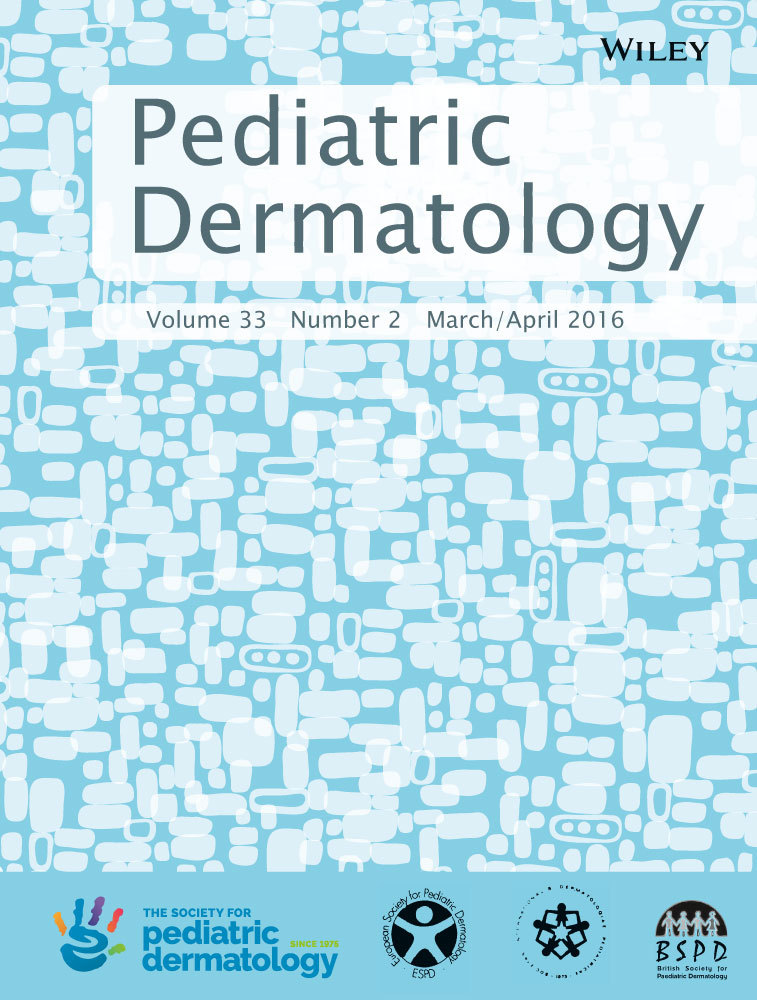Iatrogenic Necrolytic Migratory Erythema in an Infant with Congenital Hyperinsulinism
Corresponding Author
Carrie C. Coughlin M.D.
Division of Dermatology, Washington University School of Medicine, St. Louis, Missouri
Address correspondence to Carrie C. Coughlin, M.D., Division of Dermatology, Washington University School of Medicine, 660 S. Euclid Avenue, Campus Box 8123, St. Louis, MO 63110, or e-mail: [email protected].Search for more papers by this authorSani M. Roy M.D.
Division of Endocrinology and Diabetes, Children's Hospital of Philadelphia, Philadelphia, Pennsylvania
Search for more papers by this authorLisa M. Arkin M.D.
Department of Dermatology, Rush University Medical Center, Chicago, Illinois
Search for more papers by this authorN. Scott Adzick M.D.
Division of Pediatric General, Thoracic and Fetal Surgery, Children's Hospital of Philadelphia, Philadelphia, Pennsylvania
Search for more papers by this authorAlbert C. Yan M.D.
Section of Pediatric Dermatology, Children's Hospital of Philadelphia, Philadelphia, Pennsylvania
Department of Pediatrics, Perelman School of Medicine, University of Pennsylvania, Philadelphia, Pennsylvania
Department of Dermatology, Perelman School of Medicine, University of Pennsylvania, Philadelphia, Pennsylvania
Search for more papers by this authorDiva D. De León M.D., M.S.C.E.
Division of Endocrinology and Diabetes, Children's Hospital of Philadelphia, Philadelphia, Pennsylvania
Department of Pediatrics, Perelman School of Medicine, University of Pennsylvania, Philadelphia, Pennsylvania
Search for more papers by this authorAdam I. Rubin M.D.
Division of Pediatric General, Thoracic and Fetal Surgery, Children's Hospital of Philadelphia, Philadelphia, Pennsylvania
Department of Dermatology, Perelman School of Medicine, University of Pennsylvania, Philadelphia, Pennsylvania
Department of Dermatology, Hospital of the University of Pennsylvania, Philadelphia, Pennsylvania
Search for more papers by this authorCorresponding Author
Carrie C. Coughlin M.D.
Division of Dermatology, Washington University School of Medicine, St. Louis, Missouri
Address correspondence to Carrie C. Coughlin, M.D., Division of Dermatology, Washington University School of Medicine, 660 S. Euclid Avenue, Campus Box 8123, St. Louis, MO 63110, or e-mail: [email protected].Search for more papers by this authorSani M. Roy M.D.
Division of Endocrinology and Diabetes, Children's Hospital of Philadelphia, Philadelphia, Pennsylvania
Search for more papers by this authorLisa M. Arkin M.D.
Department of Dermatology, Rush University Medical Center, Chicago, Illinois
Search for more papers by this authorN. Scott Adzick M.D.
Division of Pediatric General, Thoracic and Fetal Surgery, Children's Hospital of Philadelphia, Philadelphia, Pennsylvania
Search for more papers by this authorAlbert C. Yan M.D.
Section of Pediatric Dermatology, Children's Hospital of Philadelphia, Philadelphia, Pennsylvania
Department of Pediatrics, Perelman School of Medicine, University of Pennsylvania, Philadelphia, Pennsylvania
Department of Dermatology, Perelman School of Medicine, University of Pennsylvania, Philadelphia, Pennsylvania
Search for more papers by this authorDiva D. De León M.D., M.S.C.E.
Division of Endocrinology and Diabetes, Children's Hospital of Philadelphia, Philadelphia, Pennsylvania
Department of Pediatrics, Perelman School of Medicine, University of Pennsylvania, Philadelphia, Pennsylvania
Search for more papers by this authorAdam I. Rubin M.D.
Division of Pediatric General, Thoracic and Fetal Surgery, Children's Hospital of Philadelphia, Philadelphia, Pennsylvania
Department of Dermatology, Perelman School of Medicine, University of Pennsylvania, Philadelphia, Pennsylvania
Department of Dermatology, Hospital of the University of Pennsylvania, Philadelphia, Pennsylvania
Search for more papers by this authorAbstract
Necrolytic migratory erythema (NME) is a rare cutaneous finding characterized by painful, pruritic, scaly red patches and plaques, bullae, and superficial erosions. Typically NME is a paraneoplastic phenomenon associated with glucagonoma. We report the exceptional case of an infant who developed iatrogenic NME arising secondary to glucagon therapy for congenital hyperinsulinism.
References
- 1Becker SW, Kahn D, Rothman S. Cutaneous manifestations of internal tumors. Arch Dermatol Syph 1942; 45: 1069–1080.
- 2Mallinson CN, Bloom SR, Warin AP et al. A glucagonoma syndrome. Lancet 1974; 2: 1–5.
- 3Marinkovich MP, Botella R, Datloff J et al. Necrolytic migratory erythema without glucagonoma in patients with liver disease. J Am Acad Dermatol 1995; 32: 604–609.
- 4Otto AI, Marschalko M, Zalatnai A et al. Glucagon cell adenomatosis: a new entity associated with necrolytic migratory erythema and glucagonoma syndrome. J Am Acad Dermatol 2011; 65: 458–459.
- 5Masri-Fridling GD, Turner ML. Necrolytic migratory erythema without glucagonoma. J Am Acad Dermatol 1992; 27: 486.
- 6Bak H, Ahn SK. Pseudoglucagonoma syndrome in a patient with malnutrition. Arch Dermatol 2005; 141: 914–916.
- 7Stavropoulos PG, Papafragkaki DK, Avgerinou G et al. Necrolytic migratory erythema: a common cutaneous clue of uncommon syndromes. Cutis 2013; 92: E1–E4.
- 8Barber SG, Hamer JD. Skin rash in patient receiving glucagon. Lancet 1976; 2: 1138.
- 9Case CC, Vassilopoulou-Sellin R. Reproduction of features of the glucagonoma syndrome with continuous intravenous glucagon infusion as therapy for tumor-induced hypoglycemia. Endocr Pract 2003; 9: 22–25.
- 10Mullans EA, Cohen PR. Iatrogenic necrolytic migratory erythema: a case report and review of nonglucagonoma-associated necrolytic migratory erythema. J Am Acad Dermatol 1998; 38: 866–873.
- 11Wald M, Lawrenz K, Luckner D et al. Glucagon therapy as a possible cause of erythema necrolyticum migrans in two neonates with persistent hyperinsulinaemic hypoglycaemia. Eur J Pediatr 2002; 161: 600–603.
- 12van Beek AP, de Haas ER, van Vloten WA et al. The glucagonoma syndrome and necrolytic migratory erythema: a clinical review. Eur J Endocrinol 2004; 151: 531–537.
- 13Blackford S, Wright S, Roberts DL. Necrolytic migratory erythema without glucagonoma: the role of dietary essential fatty acids. Br J Dermatol 1991; 125: 460–462.
- 14Peterson LL, Shaw JC, Acott KM et al. Glucagonoma syndrome: in vitro evidence that glucagon increases epidermal arachidonic acid. J Am Acad Dermatol 1984; 11: 468–473.
- 15Bloom SR, Polak JM. Glucagonoma syndrome. Am J Med 1987; 82: 25–36.
- 16Nakashima H, Komine M, Sasaki K et al. Necrolytic migratory erythema without glucagonoma in a patient with short bowel syndrome. J Dermatol 2006; 33: 557–562.
- 17Palladino AA, Bennett MJ, Stanley CA. Hyperinsulinism in infancy and childhood: when an insulin level is not always enough. Clin Chem 2008; 54: 256–263.




